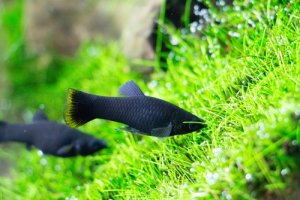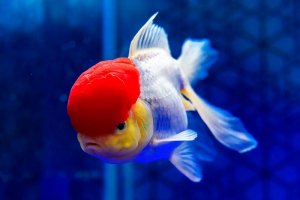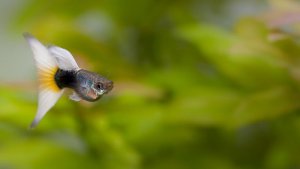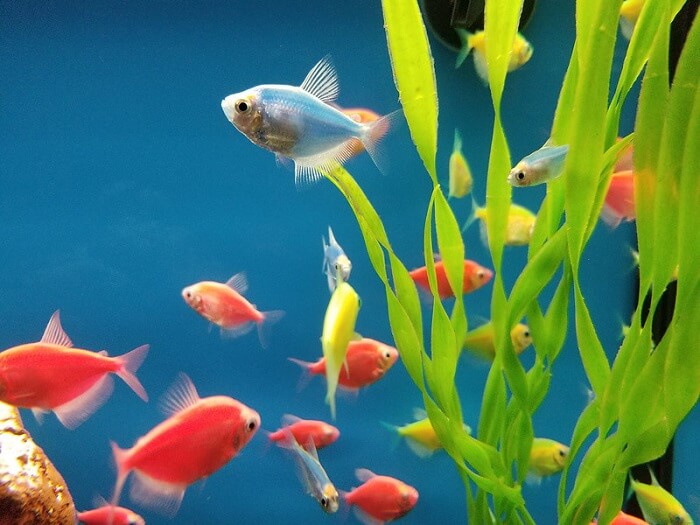
One thing that attracts many people to keeping ornamental fish is their vivid colors. Sometimes, it is hard to believe that their iridescent tones are natural, but in fact, tropical freshwater fish can come in a variety of dazzling displays that are sure to brighten up any room.
So, if it’s color you’re looking for, this guide with go over Cichlids, Guppies, Killifish, and other colorful varieties. Read on to find out the top 15 species.
How To Choose Colorful Freshwater Aquarium Fish
If you’re a beginner aquarist, it can be tempting to go for the most colorful fish you can see. But remember that planning a tank in advance will ensure you have a great environment full of happy, healthy fish. Not all fish are compatible with all environments, and as a result, it’s important to understand what things to take into account when choosing fish.
Firstly, water temperature is very important. Some fish are hardy, like Guppies, whereas others, like the Discus, are more sensitive. It’s important to not put sensitive fish in the same conditions as hardy tankmates.
Secondly, certain tankmates can cause aggression. Read on for a breakdown of some of the most colorful freshwater aquarium fish and the environments they need.
What Are The Most Colorful Freshwater Fish?
Walking into a pet shop you will see there are many stunning and colorful fish. However, they don’t all require the same care, as we outlined above. Thus, the following guide will show you what conditions some of the most popular species require. Without further ado, here are the top 15 to consider for both beginners and experts alike who want something colorful and eye-catching:
1. Paradise Gourami
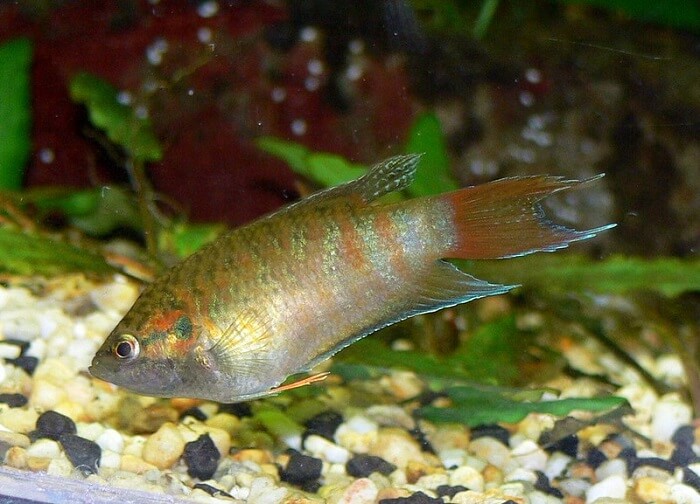
| Temperature | 68-82 F (20-28 C) |
| Minimum tank size | 20 gallons (76 liters) |
| Size | 2-3 inches or max 7 cm |
| pH | 7 |
| Food | Carnivore |
| Temperament | Can be aggressive |
| Tankmates | Tetras, Cichlids, Rasboras, Danios |
The Paradise Gourami is a striking Gourami fish that can be found in rice paddies and slow-moving streams across East Asia from Vietnam all the way north to Korea. As a result, it does not require as high a temperature as some other fish on this list. Therefore, ensure any tankmates can live in their range.
Aside from this, these guys can be aggressive and territorial, so ensure you have a big enough tank. They can occasionally be kept in groups but as a rule of thumb, it’s best to treat them like Betta Fish and keep one male alone or a group of 5-6 females.
2. Fancy Guppy
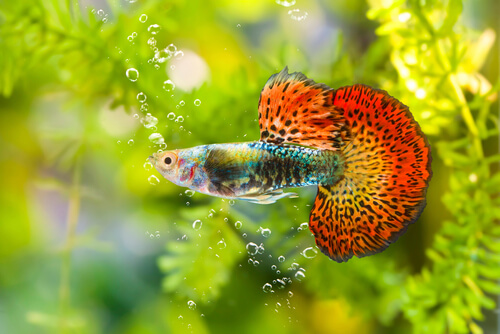
| Temperature | 72-82 F (22-28 C) |
| Minimum tank size | 20 gallons (76 liters) |
| pH | 6.0-7.0 |
| Food | Omnivorous |
| Temperament | Curious, lively, can be aggressive |
| Tankmates | Endler’s livebearers, Rasboras, Cichlids, Platies, Mollies, Swordtails, Cory Catfish, Kuhli Loaches, Pleco fish (certain varieties) |
Fancy Guppies have been bred in captivity for a long time now. This selective breeding gave rise to a very wide variety of colors and morphs including the cobra Guppy, tuxedo Guppy, and many more.
Guppies can be semi-aggressive fin nippers, so ensure they have enough space. In addition, keep one or two males for every three to four females. These fish are livebearers, and males will harass the females to try and mate with them – but we have plenty of guides such as ‘how Guppies mate’ to help you understand how to take optimum care of these little fish.
3. Cardinal Tetra
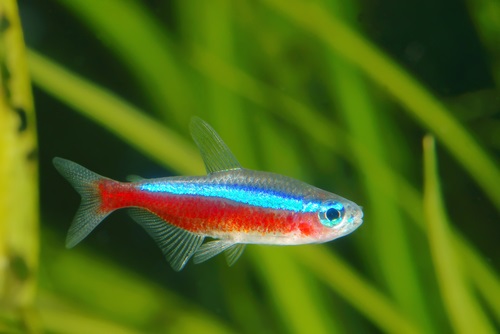
| Temperature | 76-82 F (25-28 C) |
| Minimum tank size | 10 gallons (38 liters) |
| pH | 5.5 – 6.5 |
| Food | Omnivorous |
| Temperament | Curious and active |
| Tankmates | Other Tetras, Rasboras, larger Amazonian tankmates like angel fish and Discus, small Cichlids, Cory Catfish, Loaches, smaller Pleco species |
The Cardinal Tetra is an unusual, vivid species of Tetra from South America. It’s best to keep them with other hardy fish like Guppies as these guys come from blackwater streams that are full of organic matter and have a low pH. Thus, you need tankmates from a similar habitat that can tolerate this pH.
In addition, Cardinal Tetras need relatively low lighting as the streams and tributaries they live in are overshadowed by the rainforest canopy. They do not do well with a bright LED light. However, dim lighting makes it even easier to see their majestic colors, which involve a dual stripe of red and blue.
4. Betta Fish
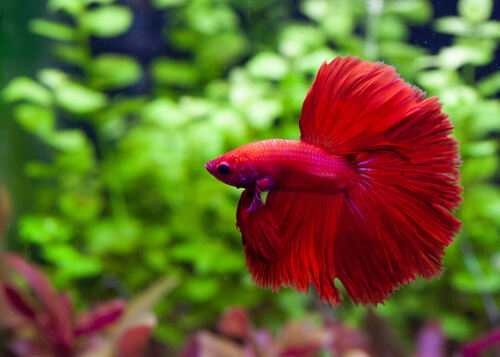
| Temperature | 76-82 F (24-28 C) |
| Minimum tank size | 30 gallons/114 liters |
| pH | 7 |
| Food | Carnivorous, prefers free swimming live or frozen protein, with specialist Betta flakes as a base |
| Temperament | Can be aggressive, generally solitary, hierarchal in female community tanks |
| Tankmates | Danios, Rasboras, Kuhli Loaches, Cory Catfish, Tetras, Mollies, Platies |
The Betta Fish is a spectacular fish with a stunning long tail and it can come in a wide variety of vivid colors. Between their coloration and tail types such as veilteil, plakat, crowntail, and half-moon, there is an enormous range of Betta Fish looks to choose from
The most important thing to note is that you should never keep two male Bettas in the same tank, as they will fight each other to the death. This is what gives them their alternative name of ‘Siamese fighting fish’. However, a sorority tank of 5-6 females is an option for those who want to keep multiple Betta Fish. We also have a list of ‘best Betta Fish tankmates’ so you can ensure all fish get along.
5. Discus Fish
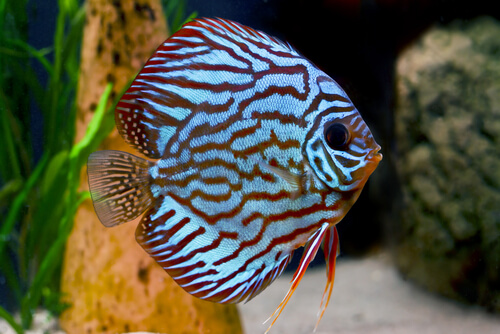
| Temperature | 86 F or 30 C |
| Minimum tank size | 50 gallons (227 liters) |
| pH | 6.5-6.8 |
| Food | Omnivore |
| Temperament | Peaceful and shy |
| Tankmates | Cory Catfish, Amazonian Pleco species, Mollies, Platies, Rasboras, Tetras, and Loaches, as well as small Cichlids like the Blue Ram Cichlid |
Discus fish get their name from their flattened, round shape, like a Discus. These fish are part of the Cichlid family and have vivid mottled coloring of turquoise, peach, red, and blue. They live in the Amazon basin river system in South America.
Discus fish are notable for being sensitive and having a very shy personality. They refer to be kept in shoals of 5-6. One example of their sensitivity is that their temperature range is not as large as some other fish. Thus, it’s best to keep them with hardy tankmates like Rasboras, Mollies, and Platies. Apart from this, they have vivid mottled coloring of turquoise, peach, red, blue, and much more.
6. Killifish Species
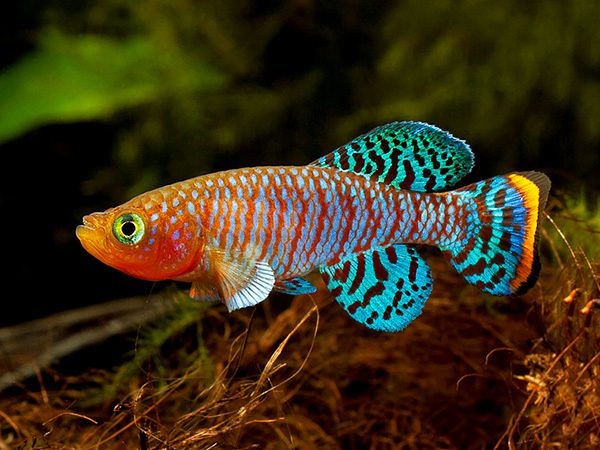
| Temperature | 68-86 F (20-30 C) depending on species |
| Minimum tank size | 20 gallons or 76 liters for a pair on average |
| pH | 6.5-7.5 |
| Food | Omnivore, enjoys both flakes and plant-based pellets plus live protein |
| Temperament | Peaceful, tolerant, friendly |
| Tankmates | Other small and peaceful tropical fish like Tetras, Rasboras, and Danios. |
What are Killifish? These tropical fish are not very well known due to their short lifespan which means they are slightly less common or publicized. However, they more than make up for this with their incredible colors! Many Killifish species such as the Turquoise African Killifish are used as model organisms in scientific research on aging as a result of their short lifespan.
The Killifish group refers to several families but all fall under the wider umbrella of egg-laying tooth carps. This means they are distantly related to livebearing tooth-carps like familiar favorites Guppies, Mollies, and Platies.
Killifish have magnificent colors and are generally hardy. Although not strictly aggressive, they can also be territorial, however.
7. Apistogramma Cichlid
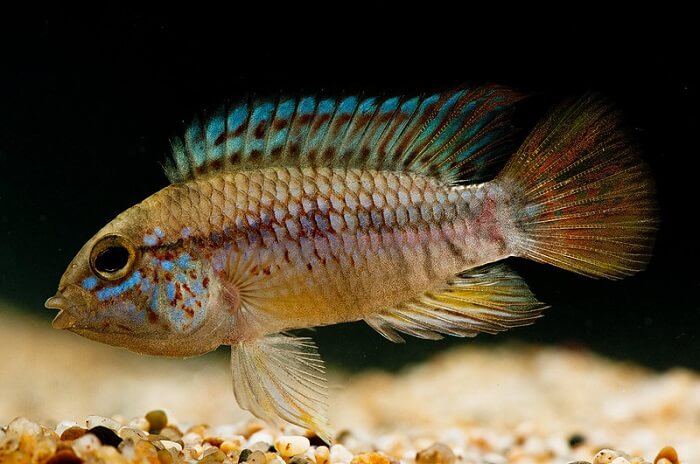
| Temperature | 72 to 84 F(22 – 28 C) |
| Minimum tank size | 30 gallons or 114 liters |
| pH | 6.0 to 7.0 |
| Food | Omnivorous |
| Temperament | Curious and semi-aggressive |
| Tankmates | Cory Catfish, Tetras, Plecos, and other Apistogrammas |
Apistogramma Cichlids are not a single species of fish. Instead, they are a colorful family of fish that are native to South America and generally break the mold of usual Cichlid behavior, making them a popular choice for many tanks. Whilst Cichlids can have a reputation for aggression as well as for growing very large, these dwarf Cichlids are only semi-aggressive and otherwise have a curious and relatively playful disposition.
They’re also renowned for their dazzling color display that ranges from blues and yellows to reds, silvers, and more, as well as unusual fins such as on the cockatoo Apistogramma Cichlid.
8. Oscar Fish
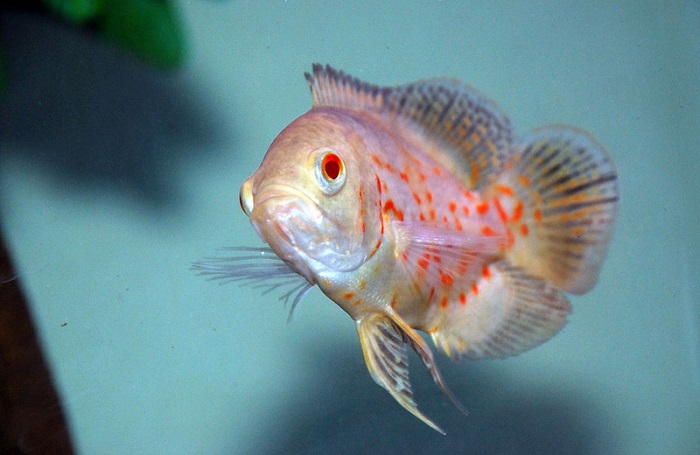
| Temperature | 75-82 F or 24-28 C |
| Minimum tank size | 125 Gallons (670 liters) |
| pH | 6.0-8.0 |
| Food | Omnivorous, but requires meat |
| Temperament | Can be aggressive |
| Tankmates | Pleco fish, Sharks (bala and red-tail Shark) other Cichlids (Jack Dempsey, Firemouth Cichlid, Convict Cichlid, Arowana, Blood Parrot fish) |
Oscar fish are also known as the Oscar Cichlid and are a massive Cichlid that can reach up to 45 cm! These guys are carnivorous, and prey on other fish in the wild. They’re definitely not fish for beginners, but they are one of the most striking and colorful fish in the aquarium hobby.
Aside from needing a larger tank, they also require large food such as worms, crickets, and other insects. You can purchase these from aquarium stores. In the wild, they also occasionally eat fruit and nuts.
9. Electric Blue Ram
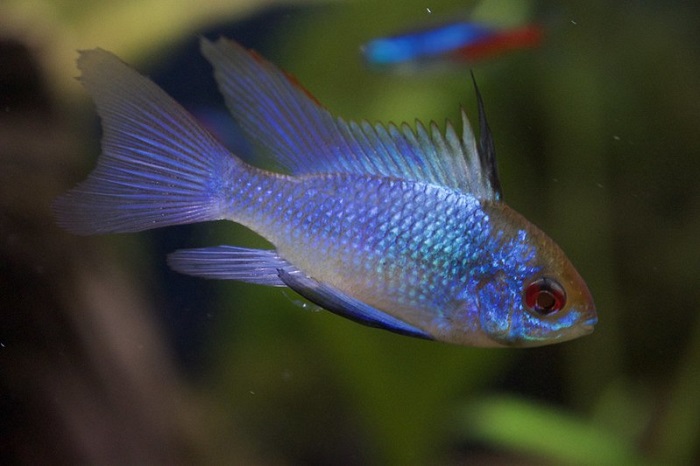
| Temperature | 78 – 84 F or 25-29 C |
| Minimum tank size | 20 gallons (76 liters) for a pair or 40 gallons (182 liters) for a group of 4 |
| pH | 6.5-7.0 |
| Food | Omnivorous |
| Temperament | Social and curious |
| Tankmates | Other Cichlids, Tetras, Rasboras, Cory Catfish, angelfish, Loaches, Pleco fish |
The blue ram Cichlid is one of the Cichlid species that stands out for its social behavior. Although not all Cichlids are social and many are aggressive, these guys are actually quite the opposite.
On top of this, they catch the eye with their pearly, vivid blue-turquoise scales.
Cichlids in general require some experience to look after, but this is a great species that doesn’t grow too big and looks amazing as well.
10. Roseline Shark
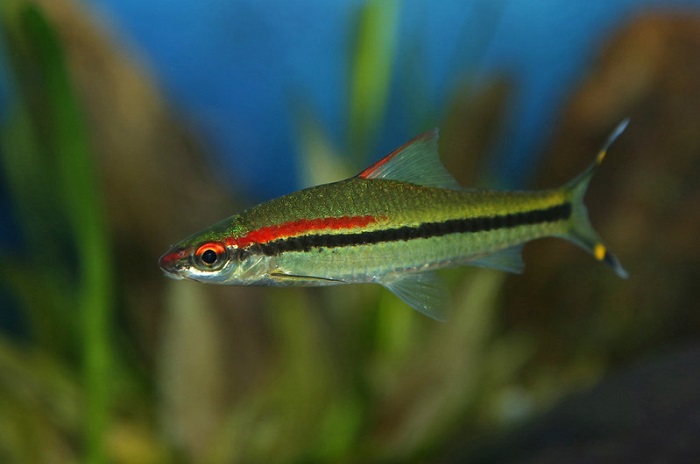
| Temperature | 72-76 F or 22 – 25 C |
| Minimum tank size | 55 gallons (250 liters) |
| pH | 6.5 – 7.5 |
| Food | Omnivorous |
| Temperament | Bold and territorial |
| Tankmates | Tetras, other barbs, Gouramis, Rasboras, Danios, small Cichlids, Pleco fish |
The Roseline Shark is not a type of Shark at all but is instead some of the barb family. What’s good about this fish is it can be kept with a great variety of tankmates including numerous other colorful barb species like the cherry barb and gold barb. However, these guys can grow big, so make sure you have a big enough tank for them!
Roseline Sharks need company and prefer a shoal of 5-6. As a result, you will definitely need to plan a large tank, of at least 55 gallons, in order to keep them properly.
11. Tropheus Cichlid
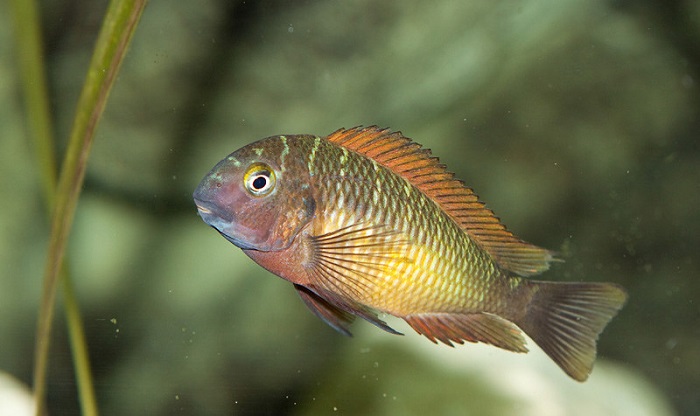
| Temperature | 76 – 82 F or 22 – 27 C |
| Minimum tank size | 100 gallons (455 liters) |
| pH | 7.8-9.0 |
| Food | Mostly vegetarian but occasionally eats meat |
| Temperament | Bold and friendly, but occasionally aggressive especially when breeding |
| Tankmates | Gobies, Malawi Cichlids |
Another fish that is definitely not for beginners, the Tropheus Cichlid comes from Lake Tanganyika, in East Africa, where it generally lives close to the shore. It is a very social fish and as a result, it gives you the best of both color and behavior.
However, it is important to give these fish the right habitat. Their surprising colors with bands of blue and vivid fins may catch your eye, but they do require very clean water and an appropriate-sized tank. However, they can be a great option if you have experience with Cichlids.
12. Chili Rasbora
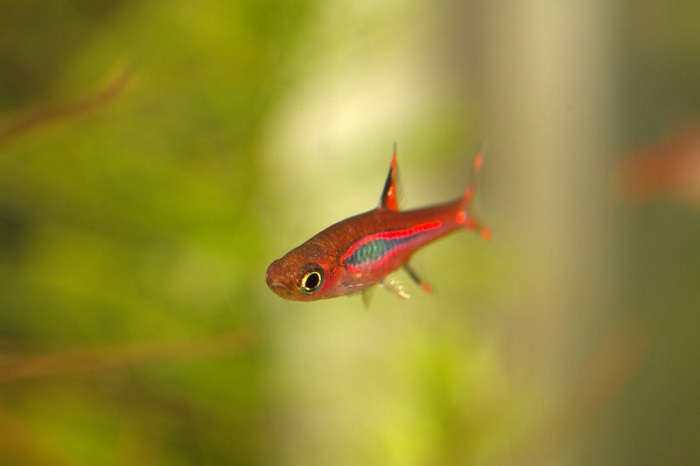
| Temperature | 72-82 F or 22-28 C |
| Minimum tank size | 10 gallons (38 liters) |
| pH | 5.0-7.0 |
| Food | Omnivore |
| Temperament | A shy, schooling fish |
| Tankmates | Perfect with many larger fish like angelfish and Discus fish as well as Plecos, Cory Catfish, Kuhli Loaches, Danios, and other Rasboras like the Harlequin Rasbora |
The Chili Rasbora is a surprisingly small Rasbora species that makes a startling and brilliant addition to your tank. Rasbora species are found all across South and South East Asia such as India and Sri Lanka, although this one specifically comes from Borneo. The deep red hue, like chili pepper, that gives it its name means it is certainly one of the most vibrant colored freshwater aquarium fish out there.
What also makes these guys popular is they can get on with a wide variety of tankmates and they are also popular for nano tanks and small spaces due to their minute size.
Author’s Note: You can actually keep these fish in a 10-gallon aquarium and they will still thrive, although if you add tankmates of a larger size, 20 or 30 gallons may be better.
13. Kribensis Cichlid
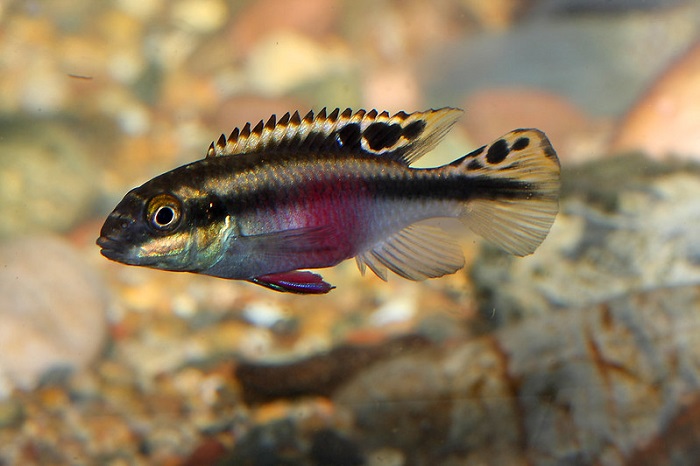
| Temperature | 75-78 F or 24-26 C |
| Minimum tank size | 30 gallons or 114 liters for one |
| pH | 5.5-7.0 |
| Food | Omnivore |
| Temperament | Hardy and peaceful, especially by Cichlid standards |
| Tankmates | Tetras, Gouramis, other Cichlids (providing non-aggressive), Rasboras, Pleco fish, Cory Catfish, and other bottom-dwelling fish like Kuhli Loaches |
Compared to some other Cichlids, the Kribensis Cichlid is relatively small, peaceful, and trouble-free – plus it has amazing colors. These fish come from Nigeria and Cameroon originally, but they are now captive-bred and are very hardy. They make a good Cichlid species for beginners as a result of this.
If you want to keep them, remember that they are a dwarf species. They only grow about 4 inches long for males and 3 inches long for females. Therefore, you can easily keep them with other tankmates.
14. Celestial Pearl Danio
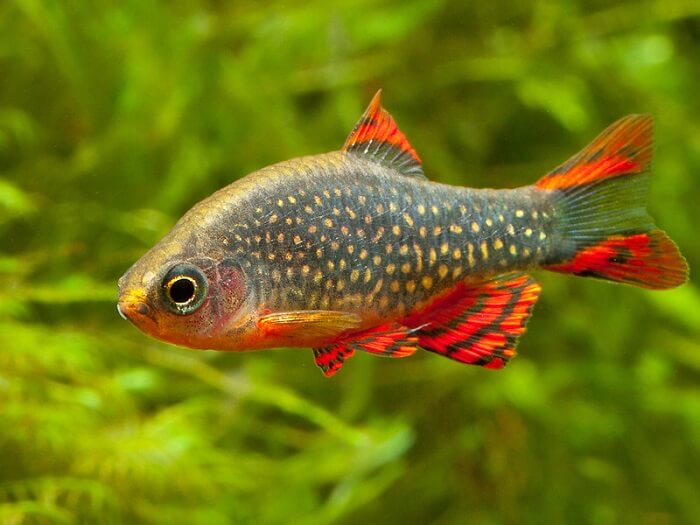
| Temperature | 72-76 F or 22-24 C |
| Minimum tank size | 20 gallons or 76 liters (group of 6) |
| pH | 7.0-8.0 |
| Food | Omnivore |
| Temperament | Bold, peaceful, and friendly |
| Tankmates | Other Danios, Rasboras, larger Cichlids, bottom-dwelling Catfish and Plecos, barb species |
All Danio species are hardy and peaceful tankmates that can get on with a variety of fish. They sometimes have a reputation for fin nipping, but given enough room, this is rarely a problem.
The classic zebra Danio with its black and white stripes is a striking fish, but if you want a more colorful Danio species, the Celestial Pearl Danio is the right one for you. These fish have a beautiful, mother-of-pearl marbling pattern. Either way, care, and feeding are similar to the zebra Danio, so take a look at some of our other articles, like ‘What Do Zebra Danio Eat?’ for a rough idea.
They are not as conventionally colorful as some of the Cichlid species on this list, but their unusual pearly coloring means they definitely deserve to be included.
15. Peacock Cichlid
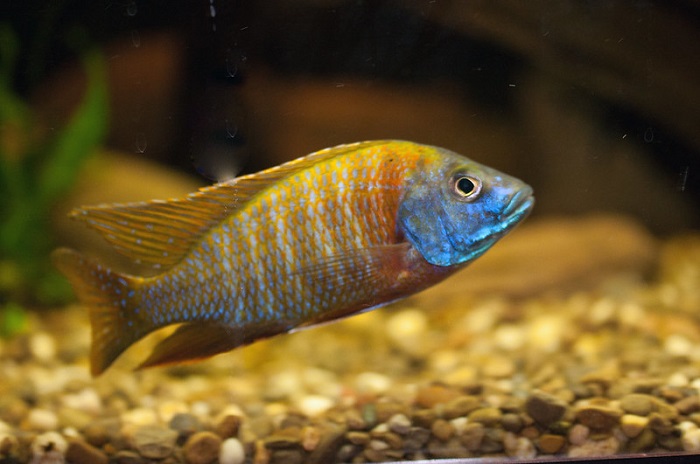
| Temperature | 76 – 82 F or 24-28 C |
| Minimum tank size | 60 gallons (273 liters) |
| pH | 7.5-8.5 |
| Food | Omnivore |
| Temperament | Peaceful in Cichlid terms, but can be aggressive |
| Tankmates | Danios, Rasboras, certain Shark species, Loaches, Plecos, and other Catfish, other Cichlid species |
This is another relatively peaceful Cichlid variety. They come from Lake Malawi in the great lakes region of Africa and tend not to have too many issues with aggression. They are relatively small too and their colors are bold and striking, taking in deep purple and sunset tones.
Like the fancy Guppy, they have a number of color varieties so there is plenty of choice if you want a colorful and low-maintenance Cichlid for a beginner large aquarium tank.
Author’s Note: Did you know many Cichlid species are endemic to the African Great Lakes Malawi, Tanganyika, and Victoria? This means they cannot be found anywhere else in the world, and the Peacock Cichlid is one of them.
Final Thoughts
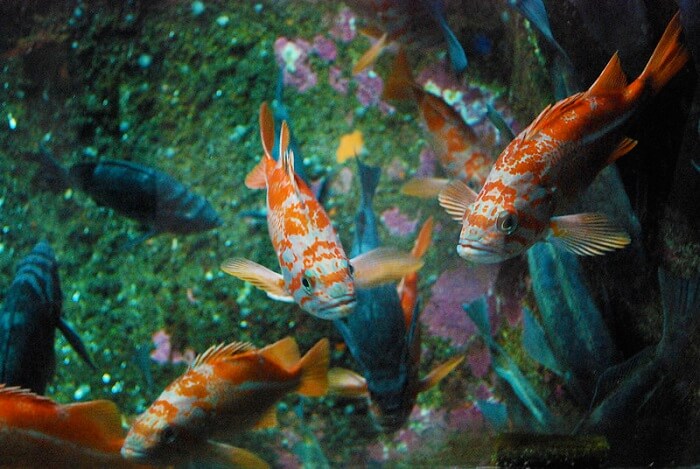
It’s difficult to classify what makes a fish the most colorful; as there are huge numbers to choose from and it depends on the needs of your individual tank as well. Thus, this list tries to include a number of different species that are appropriate for all levels of experience, as well as everything from particularly vivid single-colored fish to multicolored fish, to those with unusual colors like the Celestial Pearl Danio. Either way, there is something for every level of fishkeeper – and every color theme of your tank.


